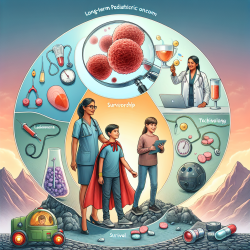Understanding the Journey: Late Effects of Childhood Leukemia Treatment
Childhood leukemia treatment has been a remarkable success story, with cure rates exceeding 90% for acute lymphoblastic leukemia (ALL) and 60% for acute myeloid leukemia (AML). However, this success is accompanied by significant long-term health challenges for survivors. According to the research article "Late Adverse Effects after Treatment for Childhood Acute Leukemia," a substantial number of survivors experience chronic health conditions that can be life-changing or life-threatening.
The Importance of Awareness and Vigilance
It is crucial for healthcare practitioners to be aware of the late effects that can arise from leukemia treatments. These effects include subsequent malignant neoplasms, metabolic toxicity, gonadotoxicity, endocrinopathy, neurotoxicity, cardiotoxicity, and psychosocial issues. By understanding these risks, practitioners can better support survivors in managing their long-term health.
Implementing Data-Driven Care Strategies
To improve outcomes for childhood leukemia survivors, practitioners should adopt data-driven care strategies. This includes utilizing electronic personalized treatment summaries and care plans, such as the Survivor Passport (SurPass), which provide tailored follow-up care based on individual risk profiles. These tools help ensure that survivors receive appropriate surveillance and interventions to mitigate the impact of late effects.
Encouraging Further Research
While significant progress has been made in understanding late effects, ongoing research is essential to uncover new insights and improve care. Practitioners are encouraged to engage in collaborative research efforts to enhance our understanding of treatment-related complications and develop innovative solutions for long-term survivorship care.
Conclusion
Raising awareness about the late effects of childhood leukemia treatment is vital for improving the quality of life for survivors. By implementing structured long-term surveillance and care strategies, practitioners can help mitigate the risks associated with these late effects. For more detailed information, practitioners are encouraged to read the original research paper, Late Adverse Effects after Treatment for Childhood Acute Leukemia.










